Evaluation of the Distant Education Methodology: The Case of Neapolis University Pafos, Cyprus
Savvas Zannetos [zannetos@gmail.com], Planning Bureau, Theodora Zachariadou [andthe@cytanet.com.cy], Engomi Primary Heath Care Centre, Alexandros Pavlakis [alexis.pavlakis@gmail.com], Synthesis Center for Research & Education, Andreas Pavlakis [a.pavlakis@nup.ac.cy], Neapolis University Pafos, Cyprus
Abstract in Greek
Το Πανεπιστήμιο Νεάπολις Πάφου προσφέρει προγράμματα σπουδών με την εξ αποστάσεως μέθοδο, από την ακαδημαϊκή χρονιά 2015 -16 και ήδη καταγράφηκαν οι πρώτοι απόφοιτοι των προγραμμάτων αυτών. Συνακόλουθα, κατέστη αναγκαίο να αξιολογηθεί η μεθοδολογία που εφαρμόστηκε και για την επίτευξη του σκοπού αυτού αποτυπώθηκαν απόψεις των φοιτητών για μια σειρά θεμάτων σε σχέση τη χρήση και την αποτελεσματικότητα της μεθοδολογίας. Συνολικά, ανταποκρίθηκαν, σχεδόν, τρεις στους τέσσερις φοιτητές οι οποίοι γενικά είναι ικανοποιημένοι από την επικοινωνία με το ακαδημαϊκό και διοικητικό προσωπικό, την ανατροφοδότησή τους για γραπτές εργασίες και τη διεξαγωγή των τηλεσυναντήσεων. Τα συγκεκριμένα ευρήματα είναι σε μεγάλο βαθμό ικανοποιητικά, δεδομένου της μικρής διάρκειας προσφοράς προγραμμάτων σπουδών με τη μέθοδο της εξ αποστάσεως εκπαίδευσης. Παρόλα αυτά ο εφησυχασμός δεν επιτρέπεται αλλά αντιθέτως, επιβάλλεται η υιοθέτηση προγραμμάτων ανάπτυξης προσωπικού – ακαδημαϊκού και διοικητικού – για την επίτευξη ολικής ποιότητας, η αναζήτηση της οποίας, εξ ορισμού, είναι συνεχής.
Keywords: Neapolis University Pafos, open distance education, students’ opinions, teleconferences, use of technology, tutor’s role
Introduction
Distance learning is a field of education described as “a process to create and provide access to learning, when the source of information and the learners are separated by time and distance or both” (Miller & Honeyman, 1993). The rapid development of information and communication technologies within the last 20 years has enabled many private and public institutions worldwide to offer pre and post graduate distance learning programs.
In Cyprus, distance learning programs are offered since 2006 (Pavlakis & Kaitelidou, 2007) as part of the first postgraduate programs offered by the first “Open University”. In this context and in order to give the opportunity to some of the population to have access to higher education by acquiring or upgrading knowledge and skills, the Neapolis University Pafos operated its Distance Education Unit. The Unit was adequately staffed with individuals specialized in distance learning and computer science, as well as other supporting staff. In October 2015, the first postgraduate programs were offered, using distance education methodology. The Master’s Degree Programs offered were the following: “Business Administration (MBA)”, “Educational Psychology” and “Public Administration”. Three main fields were developed: (a) General Administration, (b) Healthcare Management and (c) Educational Management.
In general, for the teaching of the above Programs, the following methodology was applied based on the principles of adult education as outlined in the relevant literature (Kokkos & Lionarakis, 1998):
- An e-learning platform was created in order to provide an integrated teacher–student communication system as well as student training in specially designed e-learning rooms. Students were able to use these facilities in their own study area.
- For each group of students (up to thirty) of each course, an instructor specialized on each module and with expertise in the methodology of distance learning was appointed.
- Educational material following the principles of distance learning was used. For each course, students had access to a detailed study manual according to the requirements of distance learning (Matralis, 1998).
- During each semester, there was a face to face meeting, lasting three hours. Students had the opportunity to attend at the same time as the participating students or asynchronously in their own time and space. Each phase of the individual meeting of each lesson took place on different dates in Athens and Thessaloniki so as to give to more students the chance to meet their teacher in person.
- At the same time, in each semester there were 5 to 6 two-hour teleconferences, recorded electronically, enabling students to participate either synchronously or asynchronously.
- Students were required to prepare two assignments per module, the rating of which constituted 30% of the total score. The remaining 70% was supplemented by scoring the final written examination.
- The student - teacher communication began immediately after the development of teams of students per course and was continuous and uninterrupted.
The above, roughly described methodology is based on the findings of Moskal, Dziuban, and Hartman (2013) who pointed that the success of any curriculum requires both meaningful, continuous and effective administrative support and related infrastructure as well as harmonization of the aims and objectives of students, academics and the educational institution.
In addition, it has been established that distance learning is more demanding or at least as demanding as conventional education (Pavlakis & Talias, 2011). At the same time, it is known that:
- Written papers and meetings must be well organized and effective in order to achieve their objectives. In this way they will develop into “teaching, communication, cooperative management and evaluation negotiation fields” (Nikolaki & Koutsouba, 2012).
- According to Jacobs, Winnard, and Elliott (2014) research pointed out that qualitative, specialized and consistent student feedback on their written work could have a positive effect on their final evaluation.
- The educational process through e-meeting is somewhat mysterious and perhaps dissuasive for student participation. Consequently, the instructors–advisors are required to develop effective communication with students, which should be at the heart of their educational role (Karakiza, 2010).
- Anastasiades and Iliadou (2010) found that learning outcomes are influenced by instructor–student relations. In the summary of the same article, they point out: “By means of this communication the tutor can facilitate the interaction between students and the learning material, ensure their active involvement and motivate their interest in the learning process and profound reading. In addition, effective communication between instructor–student can be a supportive tool for the students through concise and adequate feedback of their progress and provides vital encouragement.”
- Youde (2016), in his research, found that the majority of tutors-instructors in mixed learning environments communicate very well with learners. However, it has been observed that a small number of teachers lag to some extent in teaching communication skills. At the same time, a survey conducted at the Greek Open University (Kalogiannakis & Touvlatzis, 2015) found that students do not have the desired frequency of communication with their instructors-advisors. At the same time, it has been argued that in open and distance education the instructor–advisor should first and foremost support students and leave somewhere on the side-lines his role as an expert or carrier of knowledge.
- Zembylas, Theodorou, and Pavlakis (2008) have shown that students are reluctant to ask for support mainly because of fear of criticism, a sense of embarrassment due to ignorance of the right answer and lack of self-confidence.
- Hadzilakos, Papadakis, and Rossiou (2007) argue that Group Counselling Tutorials are a form of communication that is important for students not only because they have the opportunity to support and encourage each other, but also because their instructor has the opportunity to encourage them.
- Karatza (2005), in a theoretical approach to the role of the professor in lifelong learning, points out that the role is that of the facilitator, so he/ she must be honest, authentic and be himself/ herself in the educational process. Therefore, the dimensions of the professor’s role relate to his / her educational background, his / her development as a person and as a professional The most important dimension according to Karatza (2005) is the awareness of the advisor’s role.
- E-learning is efficient, fast and reliable, but in order to achieve its goals, it requires appropriate educational and academic planning and not just the implementation of a technological process (Pantano-Rokou, 2005).
Based on the aforementioned literature and given the fact that the internal evaluation of the educational services provided is a legal obligation in Cyprus (Law 136 (I) / 2015) as well as considering that the users’ opinions are crucial, we proceeded to record the related views of students. At the same time, this work implements the three major pillars of quality, as formulated by one of the quality gurus, Juran: Design – Control – Improvement of Quality (Zavlanos, 2006).
Objective
The aim of this study was to assess the views and attitudes of students of Neapolis University Pafos regarding the effectiveness of the teaching methodology used in postgraduate programs offered by Open Distance Learning (ODL).
Methodology
Sample
The research population consisted of all students enrolled in the ODL programs of the Neapolis University Pafos. An online questionnaire was sent to 378 students. From those 276 responded, yielding a response rate of 73%. A total of 254 questionnaires were finally included in the survey because some were incomplete or the file was in a form that was not recognizable by the computer.
Questionnaire
The questionnaire was a combination of two questionnaires used in related surveys (Lionarakis & Papademetriou, 2003; Pavlakis & Talias, 2011; Valkanos, Papavassiliou-Alexiou, & Fragoulis, 2009). The overall questionnaire consisted of 31 closed-ended questions and an open ended question regarding the role of their tutor-advisor as compared to that of a tutor in conventional education. In particular, the questionnaire included questions assessing student’s perceptions on the following domains:
- tasks and teleworking, (the organization of e-meetings, annotation of the assignments);
- the role of instructor-advisor;
- the quality and effectiveness of communication, (usefulness and user-friendliness of the electronic platform);
- technical and administrative support, (accessibility of the meeting venues);
- the accessibility and use of library services.
Finally, the questionnaire included questions on the demographic characteristics of the students.
A five- point Likert scale was used for each question ranging from 1 = Completely Disagree to 5 = Completely Agree. Each questionnaire was accompanied by an informative note that included a detailed description of the purpose of the study, completion instructions and a consent form for participation in the study. Potential statistically significant relationships were examined using chi – square or Fisher exact test where appropriate.
Results
Demographics
The survey involved 254 students from the academic years 2015-2016. The majority of participants were women (72.9%) whereas 86.2% were less than 50 years of age. Most of the students completed the first semester of each course while only one in four had previous experience in ODL. Demographic characteristics of the study population are shown in table 1.
Table 1: Demographic Characteristics of Participants (N=254)
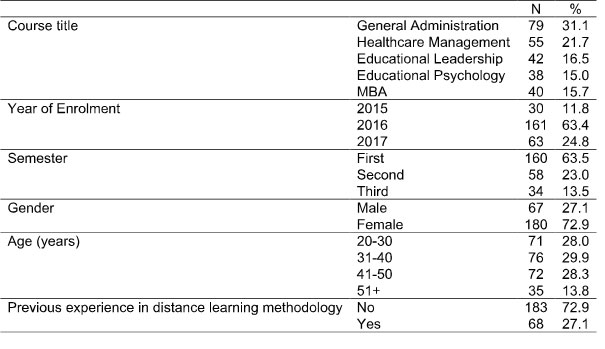
Table 2 shows the evaluation of students in relation to ODL methodology as compared to the one used in conventional education. Most of the students (45.5%) believe that training in distance learning methodology is not more difficult than receiving conventional education. Furthermore, 44.5% of participants believe that the contribution of students to ODL is more important and meaningful than the contribution to the conventional training. At the same time, 33.1% of respondents believe that preparation for written work requires more time in ODL that in conventional education.
Table 2: Percentage distribution as well as mean and standard deviation of participants’ attitudes regarding Open Distance Learning (ODL)
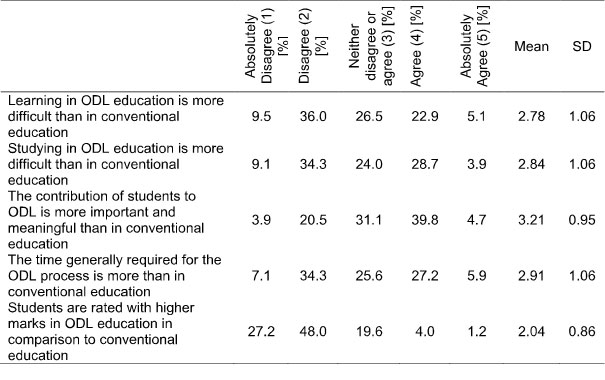
Assignments and e-meetings
Most of the participants (41.3%) reported that studying for each assignment is more time consuming as compared to that required in conventional education. More than half of the students (53.6%) believe that teaching activities used in teleconference meetings are more flexible and enriched that those used in conventional education.
Table 3: Percentage distribution as well as mean and standard deviation of participants’ attitudes regarding web-based meetings, and assignments in ODL
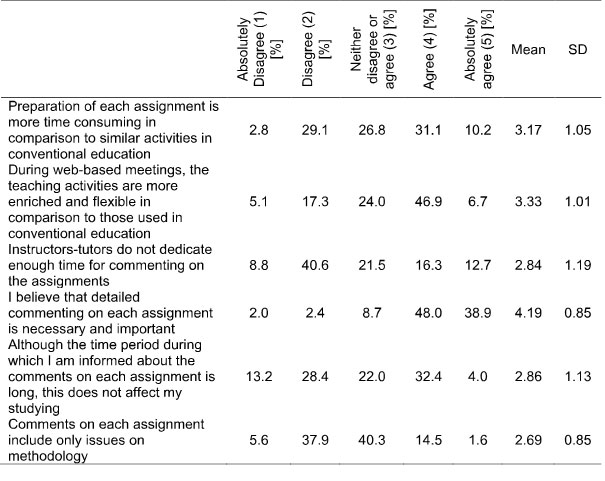
Technologies
The vast majority of participants (81.6%) believe that the online learning platform contributes effectively to their learning. More than half of the students (56.1%) believe that it would be more useful if the course material was on a digital disk or on the Web-based platform so that they would simply print it. Additionally, 61.8% of participants reported that part of the course could be on video. Finally, the overwhelming majority (86.2%) of students stated that they could use the computer and the Web-based platform very well (Table 4).
Table 4: Percentage distribution as well as mean and standard deviation of participants’ attitudes regarding technology in ODL
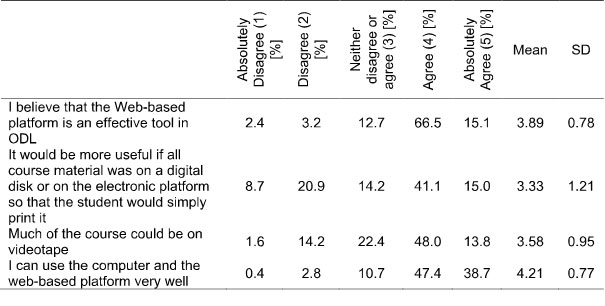
Administrative support
Regarding the Administrative support of the students, more than 75% agree or fully agree that it was very satisfactory (Table 5). It was noteworthy that 95.2% reported that they were satisfied with the communication with the program managers via telephone or e-mail.
Table 5: Percentage distribution as well as mean and standard deviation of participants’ attitudes regarding Administrative Support in ODL
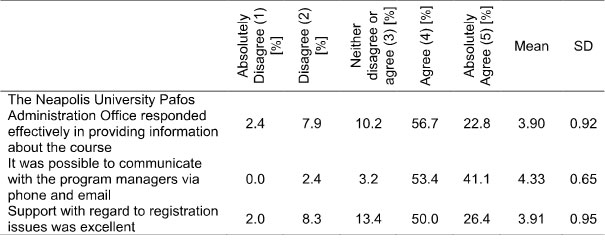
Library services
In general, most participants were rather indifferent in regard to the use of library services, since they were neutral in their statements. However, most of them stated that they were aware of the availability of library services (86%). At the same time 85.5% reported that conventional library services were comparatively better than those offered by the library of the University of Neapolis (Table 6).
Table 6: Percentage distribution as well as mean and standard deviation of participant beliefs regarding the use of library services
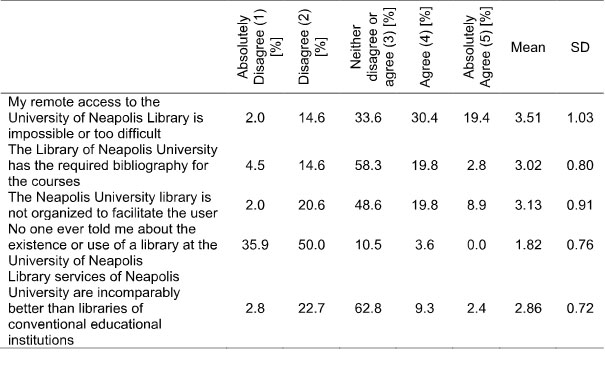
Tutor- Instructor
Approximately half of the participants stated that their tutor–instructor had a better communication with the students as compared to teachers in conventional education (Table 7). A percentage of 45.6% of students reported that at Neapolis University, Pafos the tutor- advisor delivers teaching more effectively than in conventional education.
Table 7: Percentage distribution as well as mean and standard deviation of the participants’ beliefs towards the tutor-instructor
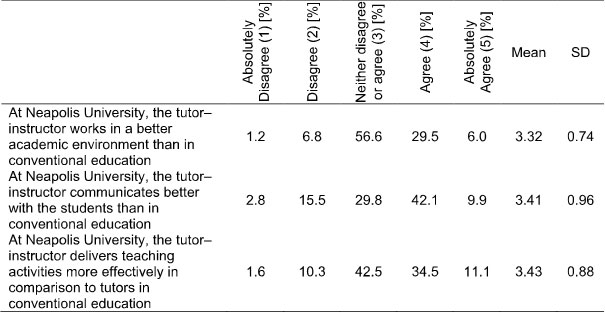
Inferential Statistics
In examining whether there was a statistically significant difference between the demographic characteristics of students and their views on ODL, no statistically significant differences in the relevant statistical tests were found (p > .05). In particular, students’ views on ODL methodology, technology, administrative support, library services and tutor-instructor were not found to be affected by curriculum, year of study, age, or gender.
Discussion
This was the first study performed in Cyprus that examined the views and beliefs of students who completed the first ODL Programs at Neapolis University Pafos. The study used an online questionnaire which included 31 questions that evaluated the students’ beliefs on the methodology applied in ODL Programs, the technology use, administrative and library services and instructor-student communication. A total of 378 questionnaires were sent electronically to all graduates and students of these Programs. The response rate of the study participants was 73%. This percentage is much higher than the response rate (55.6%) found in a comparative study of 175 academic surveys conducted between 1975 and 1995 (Baruch, 1999). At the same time, the average response rate on internet surveys is much lower (33%), as pointed by Nulty (2008), in a systematic review. A noteworthy finding in relation to the methodology applied in ODL was that approximately 33% of participants believe that studying in ODL is more difficult than in conventional education indicating a general lack of relevant knowledge or lack of interest. Most participants (44.5%) consider that their contribution to the ODL Program is more important and more substantial than in conventional education. The student contribution is realized through self-regulating and / or cooperative learning which are directly related to their academic success (Lynch & Dembo, 2004) This in turn might be the most fundamental of their motivations in their individual learning path. In addition, distance learning is characterized by learning autonomy and active participation of the student (Nikolaki & Koutsouba, 2012).
A percentage of 53.6% of students believe that during e-meetings, instructors used more enriched and more flexible learning techniques than in conventional education. These findings are important for ODL methodology because on the one hand the telecommunication is a basic function of the University of Neapolis. On the other hand, e-meetings contribute significantly to the support of the students by encouraging and guiding them in order to complete their studies. These findings are supported by the research of Hatzilakos et al. (2007). According to Mavroidis et al. (2013) teleconference meetings are an important tool for improving communication between instructor–student, exchanging views with others and solving comprehensive problems in relation to each module. However, the same researchers found that students do not really believe that telecommunication can contribute in improving their performance or their study to become more effective or to fulfil their wider mission as students. Contrary to the aforementioned survey, in the research of Milioritsa and Georgiadis (2010) it was found that e-meetings contributed to the benefit of students through communication and learning enhancement.
Most of the survey participants (41.3%) pointed out that more time is needed for studying for each assignment as compared to the relevant time required in conventional education. Approximately half of the students believe that instructors- tutors spent enough time correcting the class work. In addition, 36.4% of participants believe that there is some delay in submitting the relevant comments by the tutors, but this does not affect them in their studying. These findings are important because they are fully consistent with the relevant scientific contributions. Moreover, literature supports that written work is a remarkable interactive learning and assessment tool for students as it effectively motivates students in multiple ways, and thus self-regulated learning is supported (Jacobs et al., 2014; Nikolaki & Koutsouba, 2012; Sioulis & Gardikiotis, 2013).
The vast majority of participants (86.1%) stated that they feel comfortable in using the Neapolis University’s online learning platform. This is also supported by the high percentage (81.6%) of their belief that the we-based platform is an effective tool in their learning process. In this respect, Sirkemaa (2006) argues that the use of technology ranges from the access and delivery of educational material to the support and improvement of the learning process. Similarly, Cardoso and Bidarra (2007) point out that the use of IT in education has made distance learning feasible and easier to implement even in educational organizations without previous experience.
Approximately 80% of the participants pointed to outstanding administrative support, which undoubtedly plays a crucial role in the whole process of implementing each curriculum. This finding is fully consistent with the general prevailing view of the importance of specific support for the completion of student studies on the basis of a systemic approach (Spanaka, 2011). It may be worth noting that initiatives are needed to support the active participation of the administrative staff to further improve institutional efficiency (Welsh & Metcalf, 2003).
More than half of the participants (52%) consider that the instructor–tutor has the ability to communicate better with students than in conventional education. At the same time, almost all (95.2%) stated that they were able to communicate by telephone or otherwise with their professor. The extremely encouraging finding is in contrast to the study by Kalogiannakis and Touvlatzis (2015) who found that students do not have the desired communication with their professors. At the same time, the students sought communication with their instructor because their educational as well as emotional needs were met, and therefore the satisfaction of these needs provides the necessary impetus for their academic course (Sarakatsanou & Vasala, 2011).
Conclusions
This study was designed to examine the students’ views on the use and effectiveness of the teaching methodology used in ODL at Neapolis University, Pafos. The findings are encouraging, despite the fact that ODL is introduced during the last two years at Neapolis University. However, complacency is not allowed, but efforts must be stepped up to further improvement of the education services provided.
The technology of the educational platform has been upgraded, and our University’s collaboration with the Organization for Collective Language Management is expected to solve many of the problems in relation to the use of library services.
Instead of an Epilogue
Although findings on distance learning foretell a good quality course, it should not be overlooked that face-to-face communication remains important and largely indispensable, regardless of the specialized technology or human resources used. Consequently, it is of particular importance to keep in mind that the learning environment must be structured in such a way as to support the learning process.
References
- Anastasiades, P., & Iliadou, C. (2010). Communication between tutors-students in DL. A case study of the Hellenic Open University. European Journal of Open, Distance and E-learning, 13(2). Retrieved from http://www.eurodl.org/materials/contrib/2010/Panagiotis_Chrysoula.pdf
- Baruch, Y. (1999). Response rate in academic studies-A comparative analysis. Human relations, 52(4), 421-438.
- Cardoso, V., & Bidarra, J. (2007). Open and Distance Learning: Does IT (Still) Matter? European Journal of Open, Distance and E-learning, 10(1). Retrieved from http://www.eurodl.org/materials/contrib/2007/Cardoso_Bidarra.pdf
- Hadzilakos, T., Papadakis, S., & Rossiou, E. (2007). Group Advisory Tele-Meetings. Open Education, 5(1), 57.
- Jacobs, C., Winnard, Y., & Elliott, V. (2014). Introducing a Structured Format for Learner Selfassessment: The Tutor’S Perspective. European Journal of Open, Distance and E-learning, 17(2), 159-170. Retrieved from http://www.eurodl.org/materials/contrib/2014/Jacobs_et_al.pdf
- Kalogiannakis, M., & Touvlatzis, S. (2015). Emotions Experienced by Learners and their Development through Communication with the Tutor-Counsellor. European Journal of Open, Distance and E-learning, 18(2), 37-49. Retrieved from http://www.eurodl.org/materials/contrib/2015/Kalogiannakis_Touvlatzis.pdf
- Karakiza, T. (2010). Looking at the screen, touching the keyboard keys. Conversions of pedagogical relationship in a networked environment.
- Karatza, M. (2005). The Adult Trainers role in Supporting Lifelong Learning. Adult Education, 5, 4-8.
- Kokkos, A., & Lionarakis, A. (1998). Open and Distance Learning: Relationships between teachers and students. Patras: Hellenic Open University ed.
- Lionarakis, A., & Papademetriou, D. (2003). The quality of the learning experience: A comparative study between open distance and conventional education. Turkish Online Journal of Distance Education, 4(2).
- Lynch, R., & Dembo, M. (2004). The relationship between self-regulation and online learning in a blended learning context. The International Review of Research in Open and Distributed Learning, 5(2).
- Matralis, C. (1998). The printed material in distance education. In A. Kokkos, A. Lionarakis, C. Matralis, Panayotakopoulos (Eds.), The educational material and new technologies. Open and Distance Learning, C.
- Mavroidis, I., Karatrantou, A., Koutsouba, M., Giossos, Y., & Papadakis, S. (2013). Technology acceptance and social presence in distance education–A case study on the use of teleconference at a postgraduate course of the Hellenic Open University. European Journal of Open, Distance and E-learning, 16(2), 76-96. Retrieved from http://www.eurodl.org/materials/contrib/2013/Mavroidis_et_al.pdf
- Milioritsas, E., & Georgiadi, E. (2010). Teleconference’s impact in the learning process of the Hellenic Open University–Views of students and Tutors of Thematic Modules EKP65 and EKE50. Open Education – The Journal for Open and Distance Educational Technology, 6(1), 152-157.
- Miller, G., & Honeyman, M. (1993). Agricultural distance education: A valid alternative for higher education. Proceedings of the 20th Annual National Agricultural Research Meetins, 20, 67-73.
- Moskal, P., Dziuban, C., & Hartman, J. (2013). Blended learning: A dangerous idea? The Internet and Higher Education, 18, 15-23.
- Nikolaki, E., & Koutsouba, M. I. (2012). Support and Promotion of Self-Regulated Learning through the Educational Material at the Hellenic Open University. Turkish Online Journal of Distance Education, 13(3), 226-238.
- Nulty, D. D. (2008). The adequacy of response rates to online and paper surveys: what can be done? Assessment & Evaluation in Higher Education, 33(3), 301-314.
- Pantano-Rokou, F. (2005). Educational design for e-learning: models, meaning and impact on learning. Open Education, 1, 45-68.
- Pavlakis, A., & Kaitelidou, D. (2007). Open and Distance Education and Cyprus Reality from Idea to Materialization. Proceedings of 4th International Conference in Open and Distance Learning “Forms of Democracy un Education: Open Access and Distance Education”. Editor Antonis Lionarakis Volume B.
- Pavlakis, A., & Talias, M. (2011). The views of the Associate Educational Personnel for Distance Learning: The Experience of the Open University of Cyprus. Proceedings of 6th International Conference in Open and Distance Learning “Forms of Democracy un Education: Open Access and Distance Education”. Editor Antonis Lionarakis Volume 6, Athens.
- Sarakatsanou, E., & Vasala, P. (2011). Intermediate Interpersonal Communication of Students and Professors-Counselors in Distance Learning. Paper presented at the International Conference on Open & Distance Education.
- Sioulis, H., & Gardikiotis, A. (2013). Communication between professor and students in a distance learning environment: Students of the Hellenic Open University perceived feedback on their written work. Proceedings of 6th International Conference in Open and Distance Learning, Athens.
- Sirkemaa, S. (2006). Information technology in developing a meta-learning environment. European Journal of Open, Distance and E-learning, 9(2). Retrieved from http://www.eurodl.org/materials/contrib/2006/Seppo_Sirkemaa.pdf
- Spanaka, A. (2011). Support Services in Distance Education: The case of three open universities. Paper presented at the 6th ICODL 2011.
- Valkanos, E., Papavassiliou-Alexiou, I., & Fragoulis, I. (2009). A Study on Perceptions of Open University Students about the Use of Effectiveness of Collaborative Teaching Methods during the Tutorial Group Meetings. Review of European Studies, 1(2), 22.
- Welsh, J. F., & Metcalf, J. (2003). Administrative support for institutional effectiveness activities: responses to the ‘new accountability’. Journal of Higher Education Policy and Management, 25(2), 183-193.
- Youde, A. (2016). Tutor Emotional Competences Valued by Learners in a Blended Learning Context. European Journal of Open, Distance and E-learning, 19(2), 81-97. Retrieved from http://www.eurodl.org/materials/contrib/2016/Youde.pdf
- Zavlanos, M. (2006). Quality in services and products. Athens: Stamoulis Publications.
- Zembylas, M., Theodorou, M., & Pavlakis, A. (2008). The role of emotions in the experience of online learning: Challenges and opportunities. Educational Media International, 45(2), 107-117.
Acknowledgement
We wish to thank all those who have contributed to the realization of this work, especially our students.

